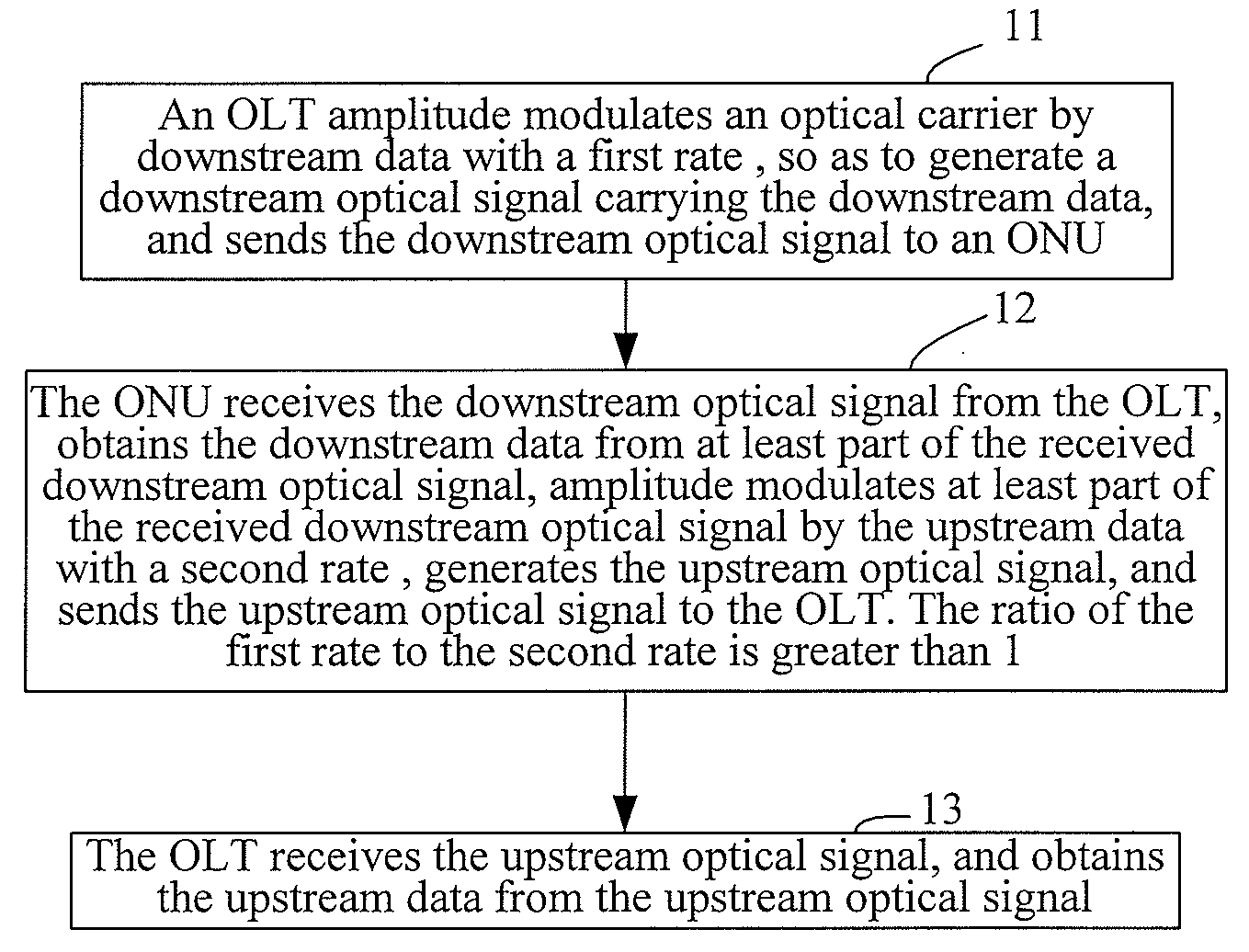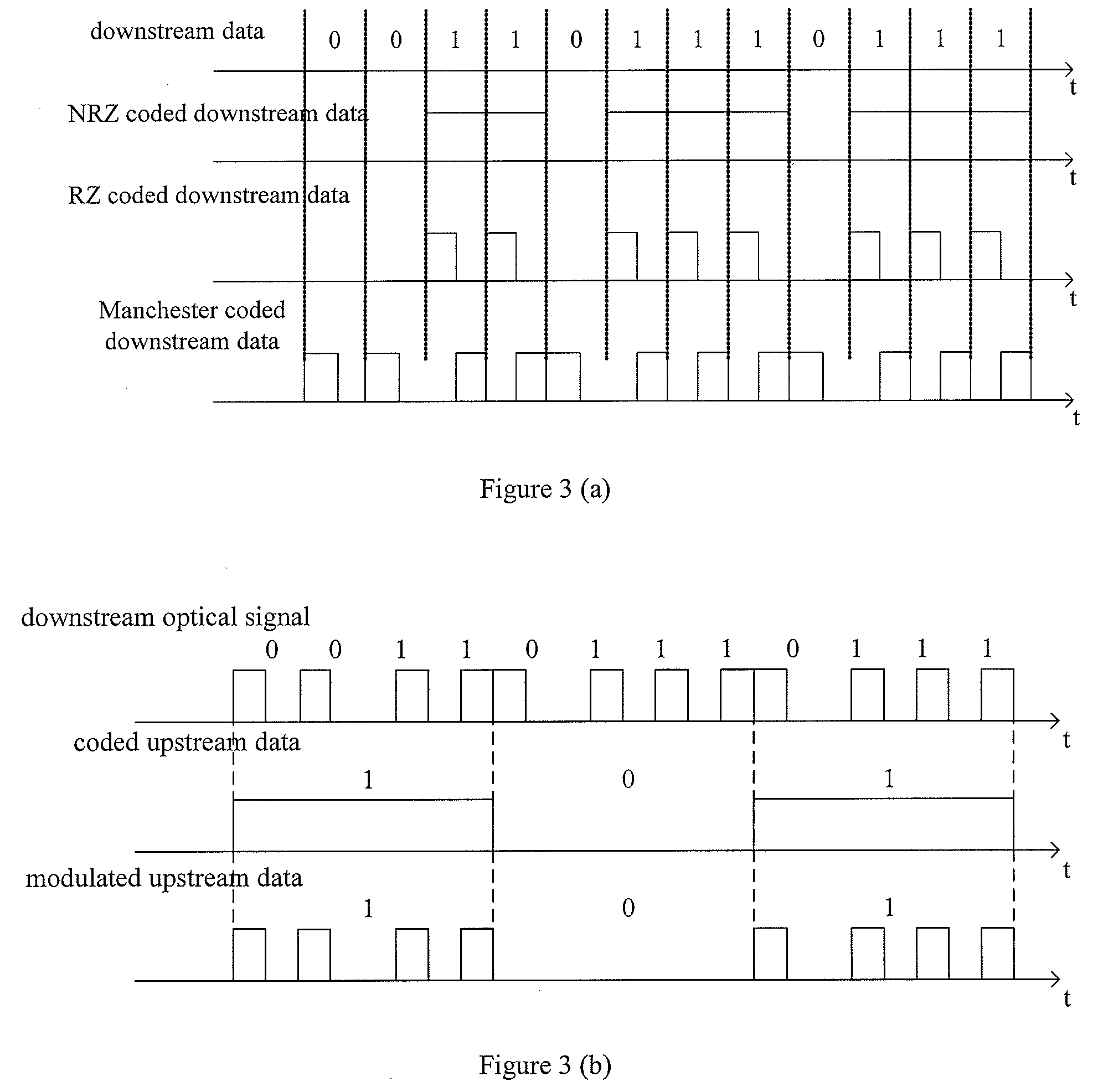Method, system and device for data transfer in an optical network
a data transfer and optical network technology, applied in the field of passive optical networks, can solve the problems of increasing the complexity and cost of the device, increasing the bit error rate of downstream data, increasing the cost of data transfer, etc., and achieves the effects of boosting the development of wdm-pon, saving energy, and reducing the complexity of the system and the device cos
- Summary
- Abstract
- Description
- Claims
- Application Information
AI Technical Summary
Benefits of technology
Problems solved by technology
Method used
Image
Examples
first embodiment
[0071]FIG. 6 is a schematic diagram showing the structure of a system for data transfer in the WDM-PON. As shown in FIG. 6, in the embodiment of the invention, the system for data transfer in the WDM-PON includes a central office device, a remote wavelength division multiplexing / demultiplexing (MUX / DEMUX) device and N user devices, where N is an integer greater than 1, such as 1, 2, 3, . . . .
[0072]The central office device 61 includes N transmitting module 611, N receiving module 612 and a central office MUX / DEMUX device 613. Corresponding to each user device 63, there are a transmitting module 611 and a receiving module 612 operating in a specific wavelength in the central office device respectively.
[0073]The transmitting module 611 is adapted to modulate with a first rate the downstream data onto the optical carrier, generate a downstream optical signal carrying the downstream data, and send the downstream data to a remote MUX / DEMUX device 62 with the downstream optical signal vi...
second embodiment
[0099]FIG. 7 shows the structure of the system for data transfer in the WDM-PON in an embodiment of the invention. As shown in FIG. 7, in this embodiment, the system for data transfer in the WDM-PON includes a central office device, a remote MUX / DEMUX device and N user devices, where N is an integer greater than 1, such as 1, 2, 3, etc.
[0100]In this embodiment, the central office device is OLT 71, the remote MUX / DEMUX device is remote AWG 72, and the user device is ONU 73.
[0101]The OLT 71 includes N transmitting modules 711, N receiving modules 712, a central office MUX / DEMUX device and a circulator 714. Here the central office MUX / DEMUX device includes central office AWG 713a and central office AWG 713b. A respective transmitting module 711 and receiving module 712 are included in the OLT 71 corresponding to each ONU 73.
[0102]A Manchester coding module 711a in the transmitting module 711 performs Manchester coding on the downstream data, send the coded downstream data to a direct m...
third embodiment
[0111]FIG. 8 shows the structure of the system for data transfer in the WDM-PON according to an embodiment of the invention. As shown in FIG. 8, the system for data transfer in the WDM-PON according to this embodiment of the invention includes a central office device OLT 81, a remote AWG 72 and ONUs 73.
[0112]In this embodiment, the remote AWG 72 and N ONUs 73 are the same as the remote AWG 72 and ONUs 73 in the embodiment as shown in FIG. 7, which will not be illustrated here again. The receiving module 712 and the central office AWG 713a as well as the central office AWG 713b in the OLT 81 are the same as the receiving module 712 and the central office AWG 713a as well as the central office AWG 713b in the embodiment as shown in FIG. 7, which will not be illustrated here again. In this embodiment, the Manchester coding module 711a in the transmitting module 811 is the same as the Manchester coding module 711a in the embodiment as shown in FIG. 7, which will not be illustrated here ...
PUM
 Login to View More
Login to View More Abstract
Description
Claims
Application Information
 Login to View More
Login to View More - R&D
- Intellectual Property
- Life Sciences
- Materials
- Tech Scout
- Unparalleled Data Quality
- Higher Quality Content
- 60% Fewer Hallucinations
Browse by: Latest US Patents, China's latest patents, Technical Efficacy Thesaurus, Application Domain, Technology Topic, Popular Technical Reports.
© 2025 PatSnap. All rights reserved.Legal|Privacy policy|Modern Slavery Act Transparency Statement|Sitemap|About US| Contact US: help@patsnap.com



